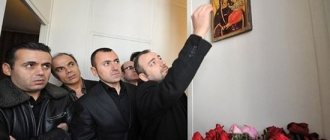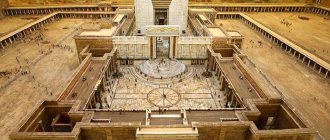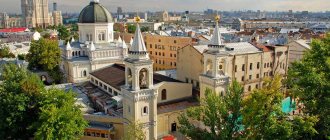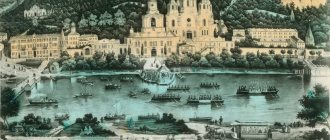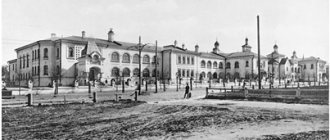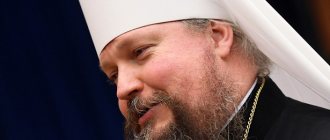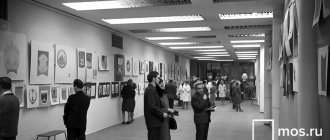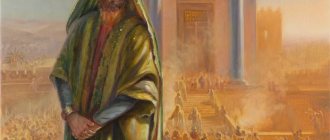Mir
France Ile-de-France Holy Trinity Cathedral (Paris) Map loading in progress...
{"format":"leaflet","minzoom":false,"maxzoom":false,"limit":50,"offset":0,"link":"all","sort":[""], "order":[],"headers":"show","mainlabel":"","intro":"","outro":"","searchlabel":"\u2026 \u0441\u043b\u0435\ u0434\u0443\u044e\u0449\u0438\u0435 \u0440\u0435\u0437\u0443\u043b\u044c\u0442\u0430\u0442\u044b","default":"","import-annotation":false,"width ":"auto","height":"350px","centre":{"text":"","title":"""link":"""lat":48.86200000000000187583282240666449069976806640625,"lon": 2.300983000000000000540012479177676141262054443359375,"icon":""},"title":"","label":"","icon":"","lines":[],"polygons":[],"circles":[ ],"rectangles":[],"copycoords":false,"static":false,"zoom":8,"defzoom":14,"layers":["OpenStreetMap"],"image layers":[] ,"overlays":[],"resizable":false,"fullscreen":true,"scrollwheelzoom":true,"cluster":false,"clustermaxzoom":9,"clusterzoomonclick":true,"clustermaxradius":80, "clusterspiderfy":true,"geojson":"","clicktarget":"","showtitle":true,"hidenamespace":false,"template":"","userparam":"","activeicon": "","pagelabel":false,"ajaxcoordproperty":"","ajaxquery":"","locations":[{"text":"\u003Cb\u003E\u003Ca href=\"/palomnik/%D0% A1%D0%B2%D1%8F%D1%82%D0%BE-%D0%A2%D1%80%D0%BE%D0%B8%D1%86%D0%BA%D0%B8%D0%B9_ %D1%81%D0%BE%D0%B1%D0%BE%D1%80_(%D0%9F%D0%B0%D1%80%D0%B8%D0%B6)\» title=\»\u0421 \u0432\u044f\u0442\u043e-\u0422\u0440\u043e\u0438\u0446\u043a\u0438\u0439 \u0441\u043e\u0431\u043e\u0440 (\u041f\u0430\u0440 \u0438\u0436)\»\ u003E\u0421\u0432\u044f\u0442\u043e-\u0422\u0440\u043e\u0438\u0446\u043a\u0438\u0439 \u0441\u043e\u0431\u043e\u0440 (\u041f\u 0430\u0440\u0438\u0436) \u003C/a\u003E\u003C/b\u003E\u003Chr /\u003E\u003Ca href=\»/palomnik/%D0%A1%D0%B2%D0%BE%D0%B9%D1%81%D1%82 %D0%B2%D0%BE:%D0%90%D0%BD%D0%BD%D0%BE%D1%82%D0%B0%D1%86%D0%B8%D1%8F\» title=\ »\u0421\u0432\u043e\u0439\u0441\u0442\u0432\u043e:\u0410\u043d\u043d\u043e\u0442\u0430\u0446\u0438\u044f\»\u003E\u0410\u043 d\u043d\u043e\u0442 \u0430\u0446\u0438\u044f\u003C/a\u003E: \u0431\u044b\u043b \u043e\u0441\u0432\u044f\u0449\u0435\u043d \u0421\u0432\u044f\u0 442\u0435\u0439\u0448\ u0438\u043c \u041f\u0430\u0442\u0440\u0438\u0430\u0440\u0445\u043e\u043c \u041c\u043e\u0441\u043a\u043e\u0432\u0441\u043a\u0 438\u043c\u0438\u0432\u0441\ u0435\u044f \u0420\u0443\u0441\u0438 \u041a\u0438\u0440\u0438\u043b\u043b\u043e\u043c 4 \u0434\u0435\u043a\u0430\u0431\u0440 \u044f 2016 \u0433\u043e\u0434\ u0430. \u0412\u0445\u043e\u0434\u0438\u0442 \u0432 \u043a\u043e\u043c\u043f\u043b\u0435\u043a\u0441 \u0420\u0443\u0441\u0441\u043a \u043e\u0433\u043e \u0434\u0443 \u0445\u043e\u0432\u043d\u043e-\u043a\u0443\u043b\u044c\u0442\u0443\u0440\u043d\u043e\u0433\u043e\u0446\u0435\u043d\u0442\ u0440\u0430.","title ":"\u0421\u0432\u044f\u0442\u043e-\u0422\u0440\u043e\u0438\u0446\u043a\u0438\u0439 \u0441\u043e\u0431\u043e\u0440 (\u041f\u0 430\u0440\u0438\ u0436)","link":"","lat":48.86200000000000187583282240666449069976806640625,"lon":2.30098300000000000054001247917767614126205444335937 5,"icon":""}],,"imageLayers":[]}
48.862098; 2.300936
France, Paris, 7th arrondissement of Paris, quai Branly, 3
Ile-de-France
France
Email:
Cathedral Church of the Holy Trinity
on the Quai Branly in Paris was consecrated by His Holiness Patriarch Kirill of Moscow and All Rus' on December 4, 2021. Included in the complex of the Russian Spiritual and Cultural Center.
Russian Spiritual and Cultural Center
- a complex of four buildings:
- Cathedral of the Holy Trinity of the Korsun Diocese of the Russian Orthodox Church,
- Russian-French primary school for 150 students,
- exhibition center,
- diocesan administration buildings with a concert hall and living quarters.
The center is located in the 7th arrondissement of Paris on a territory with a total area of 4.2 thousand square meters. meters, acquired by the Russian Government, a few hundred meters from the Eiffel Tower and in close proximity to the Branly Museum, the Grand Palais and the Paris Museum of Modern Art. The territory of the center is part of the Russian Embassy in France and in this regard has diplomatic immunity.
The center project was designed by the French architect Jean-Michel Wilmotte. The official opening took place on October 19, 2016.
Cultural center in Paris
One of the most beautiful cultural centers in the world, Paris has also become the spiritual Mecca of Europe. Christianity, Judaism, Islam, Buddhism - such different and sometimes contradictory religions coexist harmoniously on the streets of the most romantic metropolis.
Orthodox center in Paris!
Recently, among many churches, an Orthodox spiritual and cultural center has been located in the capital of France.
Church of the Assumption of the Mother of God
Another small Orthodox church in the Paris suburb of Sainte-Geneviève-des-Bois is known in Russia. It was built by the architect Albert Benoit at the Russian cemetery. The frescoes inside the temple were made by the architect himself and his wife.
Address: 8 rue Léo Lagrange, Sainte-Geneviève-des-Bois
Opening hours: Saturday – from 17:00 to 19:00, Sunday – from 10:00 to 19:00
» ALSO READ ARTICLE - Russian cemetery in Paris: Sainte-Geneviève-des-Bois
The beginning of the story
The decision to build a Russian Center in Paris came from Patriarch Alexy II. On one of his visits to the world capital of romance, His Holiness noted that the number of Orthodox Parisians has increased significantly in recent years. The former church could no longer accommodate so many parishioners, which means that the High Hierarch had to take care of his flock.
Orthodox center in Paris!
Of course, the issue of constructing a new sanctuary on the territory of a foreign, albeit friendly, state had to be resolved at the state level. Immediately after the visit, Alexy II petitioned the presidents of both countries.
Thus, having secured the approval of the heads of Russia and France, His Holiness the Patriarch initiated the process of building a modern Orthodox church in Paris.
Association or fitting
Having left the subordination of the Moscow Patriarchate back in 1927 and entered directly into the subordination of the Patriarchate of Constantinople, until 2007 the ROCOR was a completely independent organization from the ROC. Moreover, if for most of the 20th century the Russian Church abroad considered the Russian Orthodox Church an accomplice of the Bolsheviks and an agent of the KGB, then the Moscow Patriarchate classified the Russian Orthodox Church Abroad as schismatics. However, after the collapse of the Soviet Union, it was Moscow that first began to take steps towards uniting the two churches. Finally, in 2007, the corresponding agreement was signed, and the ROCOR returned to the fold of the Russian Orthodox Church, but with the special status of a “self-governing church.” That is, from a formal point of view, the ROCOR recognizes the power of the Moscow Patriarchate over itself, but from an administrative and, in many ways, political point of view, it is a very independent organization. The Ukrainian and Moldavian Orthodox churches, among others, have similar statuses.
As one of the clerics said about the unification of the Russian Orthodox Church and the Russian Orthodox Church Abroad, there was not so much a unification as a “reconciliation” of the two churches. And the presence of two Orthodox cathedrals in Paris is once again proof of this. It is no coincidence that immediately after the unification of the Russian Orthodox Church and the Russian Orthodox Church Abroad, representatives of the Moscow Patriarchate began talking about the need to build a new Russian cathedral in Paris under the auspices of the Russian Orthodox Church in addition to the already existing Orthodox Church of Alexander Nevsky. And now, almost a decade later, the new church saw the light of day.
Complex structure
The center of Orthodox culture cannot definitely be called a pagoda for prayer. The plans of the clergy were to create a full-fledged complex where Orthodox Christians could take care not only of the immortal soul, but also of their cultural enlightenment.
Thus, on the territory of the mission there are several buildings: the Orthodox Church of the Holy Trinity, a bilingual Russian-French school, an exhibition center and service buildings for staff.
Russian Center in Paris (photo)
It is interesting that the building of the Russian spiritual and cultural center in Paris received the legal status of an integral part of the Russian Embassy, which means it has the same rights and privileges as the official representative office.
France found itself under the jurisdiction of the Catholic Church after the schism of the Churches in the 11th century
Orthodoxy in France in its modern form appeared in the 19th - 20th centuries, when a stream of immigrants from Orthodox countries rushed to this country due to various historical events.
If we recall the history of France itself, we can note that until the 11th century, when a split in the Churches occurred, the French dioceses were part of a single Christian Church. After the schism occurred, the entire territory of this state came under the jurisdiction of the Catholic Church.
Martyrdom of Saints Dionysius the Areopagite, Rusticus and Eleutherius. Miniature from the Minology of Basil II. 11th century
The baptism of France took place in 496, while Orthodoxy influenced it long before this date. Even before the reign of the first Christian king Clovis, the first preachers of Christianity appeared in ancient Gaul.
Church tradition says that the first bishop of Lutetia (Paris) was the Greek Dionysius the Areopagite. He suffered martyrdom on the Montmartre hill.
Numerous ascetics, saints and theologians born on French soil are still remembered in the Orthodox East.
Search and acquisition of land
Several years passed from the idea to the first stone laid. The first problem that the project organizers faced was the lack of a suitable plot of land in Paris. It was important for the diocese that the center occupy the most advantageous location for the Orthodox diaspora.
Russian Center in Paris (photo)
And so, in 2009, the city council put the ideal site up for sale. The meteorological station building, located on the central Quai Branly, was being prepared for demolition. Of course, there were many who wanted to get a tasty morsel on the banks of the Seine. The advantageous location in the heart of the French capital, the nearby Eiffel Tower, the Museum of Primitive Art and the Alma Palace made such an acquisition a profitable investment for many states.
To avoid accusations of bias in the decision, the French authorities announced a competition for the acquisition of land in the central district of Paris. At the end of the auction, the main potential buyers were Russia, Saudi Arabia and Canada.
Spiritual center in Paris
Of course, the results of the auction were influenced not only by the amounts used by the representatives of the three states. Not the least role in the decision was played by the friendly relations between the presidents of Russia and France, as well as the desire to strengthen the spiritual and historical ties of the two nations.
Thus, in February 2010, following the results of a tender, the project “Opening of the Russian Spiritual and Cultural Center in Paris” was approved. The future complex for Orthodox Parisians now has an exact address: 1 Quai Branly.
The numbers and scale of the work ahead are making my head spin. On March 19, on the banks of the Seine at a height of 37 meters (the permissible maximum according to the urban development plan), the first of five domes of the future Orthodox Cathedral in Paris will be installed: 8 tons, 12 meters in height and 11 meters in diameter. The opening of the building is scheduled for October this year, and the appearance of this gilded mastodon (produced by the Breton company Multiplast) becomes a reminder of sorts: a long-term saga in which geopolitics is mixed with architectural disputes is coming to an end, and the Holy Trinity Cathedral is taking on a real shape near the Eiffel. towers. There, on a site of 8 thousand 400 square meters, where the Météo France building was once located, a “Russian spiritual and cultural center” will appear, which, in addition to the church, will include a language school, a parish and a cultural center. Several officials will gather around the tall barriers and Bouygues construction equipment to oversee the installation and dedication. France will be represented by the Secretary of State for Relations with Parliament Jean-Marie Le Guen. Russia - Ambassador Alexander Orlov, Bishop Nestor (he will head the cathedral), Deputy Prime Minister Sergei Prikhodko and Administrator of the Russian Presidential Affairs Alexander Kolpakov. Sarkozy's support Their presence is an important signal. From the very beginning of the project, the Kremlin spared no effort to get “its” cathedral. First of all, it concerns money: the Russian state paid 170 million euros. However, it was primarily the involvement of politicians that helped overcome the obstacles. The Russian side claims that the idea of building a new church in Paris came to the mind of the late Patriarch Alexy II (died in 2008) during a visit to France in the fall of 2007, the first since the church schism of 1054. The project was “well received” by President Nicolas Sarkozy, according to Bishop Nestor, the most senior representative of the Moscow Patriarchate in France. Although during the presidential campaign Sarkozy allowed himself a number of very harsh statements against Russia, he subsequently switched to the camp of its active supporters. “The project was supervised from the Elysee Palace,” recalls one French diplomat. “It was felt that the president really wanted to please the Russians.” “It was realpolitik, the same one that pushed France to sell the Mistral ships after the war in Georgia,” adds Jean de Boishue, then an adviser to Prime Minister François Fillon (another staunch Russophile). “There were a lot of people in favor, particularly in right-wing and business circles.” Levers of influence and lobbies in Paris This issue has come to the fore more than once in the Kremlin’s relations with the Elysee Palace. In Moscow, its implementation was entrusted to the manager of the presidential affairs and his faithful ally, Vladimir Kozhin. The Russian side also took advantage of leverage and lobbyists in Paris such as ESL & Network and Prince Alexander Trubetskoy, who later found himself on the jury of an architectural competition with Jean de Boisu. Along with the support of the Elysee Palace, all this played a decisive role in the process of obtaining land on the Quai Branly, which was also claimed by Saudi Arabia and Canada. Everything was finally decided in 2010 by decree of the land department. But why was Russia in such a hurry? The cramped conditions of the Temple of the Three Saints on the Rue des Loops in the 15th arrondissement of Paris, of course, played a role. But the main thing was the desire to attract attention. “This complex should become a symbol of the historical, cultural and spiritual closeness of our two peoples,” says Ambassador Alexander Orlov, emphasizing the “multifunctional” nature of the center and, in particular, the school for 150 students. According to Bishop Nestor, this is primarily a “cultural” project. “Holy Rus' has always been used as a tool of influence abroad,” says philosopher Michel Eltchaninoff, author of Inside the Head of Vladimir Putin. “This is a message full of passion and power.” The message of a state that is not afraid to declare its commitment to its Christian roots in the capital of a secular country believed to be weakened by multiculturalism and spiritual amnesia.” In addition, the project on the Quai Branly echoes the little-noticed, but no less fierce, struggle for churches of Russian emigrants that has unfolded in France since the mid-2000s. Several churches of the descendants of the “whites” who fled from Russia, which were under the authority of the Patriarchate of Constantinople, again transferred to the Moscow Patriarchate, either by decision of the priests or by legal means. This was the case with the Orthodox Cathedral of Nice, whose cemetery is still the subject of heated battles. In Paris, an attempt to acquire a temple on Daru Street encountered opposition from some believers. As Michelle Elchaninoff notes, the decision to build a new cathedral was a response to this “half-failure.” “The president behaved naively or frivolously,” says a diplomat involved in the issue. “There was nothing absurd in the idea of building a new church, but everyone wanted to avoid Russia’s second thoughts before giving carte blanche to the construction of a center that would inevitably become the embodiment of the restoration of Russian power and the symbol of Paris.” Church of “St. Vladimir” Surprisingly, in another issue the French side showed extraordinary vigilance. The Directorate General of Internal Security (DCRI) and the Directorate General of External Security (DGSE) informed their respective ministries in 2011 about the possible installation of electromagnetic wave interception equipment by Russia. Concerns were related to the fact that the site on the Quai Branly is located near the premises of the general secretariat of the French President, the diplomatic adviser to the president and his chief of staff. Intelligence agencies recommended installing jamming systems in the area to maintain the secrecy of communications. According to our information, their demands were satisfied. It would seem that all the obstacles in the way of the Church of “St. Vladimir,” as Minister of Culture Frederic Mitterrand then ironically nicknamed it, had been removed. However, then a new, architectural chapter began in the saga of the cultural center. 444 architects A territory was allocated for the building from the perimeter outlined by UNESCO. And he, without a doubt, is destined to become one of the local attractions. Therefore, it was necessary to act carefully. Six months after acquiring the land, Russia launched a design competition. The technical specifications noted that the building should not be “caricatured” or “deliberately unmodern” in nature and should comply with the canons of “an Orthodox church with one to five domes, which are visible from the Seine and its right bank.” As many as 444 architects responded to the call. Ten were eventually selected, including Frenchmen Jean-Michel Wilmotte, Frédéric Borel and Rudy Ricciotti. The jury included representatives of the Russian church and state, as well as the French government, the Paris mayor's office, and architectural and urban planning circles. Including the SOS Paris association, which managed to defeat more than one modern project in the center of the capital, in particular Bernard Arnault’s “Samaritan Woman”. The jury's decision was made in March 2011. The winner was the project of a Spaniard of Russian origin, Manuel Nunez-Yanovsky: a classical church with a huge glass tier called “The Intercession of the Virgin”. But he was not destined to come true. Shortly before the 2012 presidential election, Socialist mayor Bertrand Delanoë expressed “strong disagreement” with the project and said its “pastoral architecture” was completely out of place. The frontal attack bore fruit. On September 28, two decisions were made “against”: by the chief French architect and the regional department for cultural affairs. On March 26, 2013, the Russian side (according to the source, it was initially afraid of such problems) terminated the contract. As a result, she chose a compromise option: Russian expert Jean-Michel Wilmotte, who took second place in the competition, became a savior sent from above. Meanwhile, François Hollande replaced Nicolas Sarkozy. Back in 2013, the president assured Vladimir Putin that the project would move forward without delay. A working group was formed headed by Vladimir Kozhin and Deputy Secretary of State Nicolas Revel. She met at least three times to smooth out the last rough edges. Jean-Michel Wilmotte got the point: “We need an Orthodox Church in Paris, not in St. Petersburg. Therefore, they wanted to add “Parisianness” to her. Wilmotte proposed a “monolithic and very calm building” that echoes the austere-looking Assumption Cathedral, a masterpiece of Moscow architecture where tsars were traditionally crowned. The Russian and French sides welcomed the “wise and suitable decision for everyone.” Demand to stop work So, the saga of the Quai Branly Cathedral will receive a harmonious conclusion? Not really. Another threat, this time a legal one, still hangs over the project. In June 2015, French law enforcement authorities “froze” the site as part of the case of the Russian oil company Yukos, which was disbanded after the conviction of its owner Mikhail Khodorovsky. The Hague court ordered Russia to pay former shareholders 45 billion euros. In response to Moscow's reluctance to pay, they secured the freezing of Russian property in several countries. YUKOS shareholders demand that construction work be stopped. A hearing in a Paris court is scheduled for March 17. Although the Russian side has nothing to worry about. The Quai Branly is to house the embassy's cultural service, giving the entire complex diplomatic immunity.
InoSMI materials contain assessments exclusively of foreign media and do not reflect the position of the InoSMI editorial staff.
Secrets and mysteries of the future complex
When a matter becomes of national importance, there is a lot of behind-the-scenes intrigue. This time, the “secrets of the Madrid court” touched upon such a seemingly godly matter.
It must be admitted that not everyone was confident that the Russian Orthodox Spiritual and Cultural Center would be able to accept. Some members of the city commune openly opposed the construction of the complex, citing the fact that the new architectural structure would not fit into the historical appearance of the capital.
Spiritual center in Paris
There are rumors that, in order to resolve this issue, the Russian special services had to launch Operation Cathedral. We are unlikely to know how the special agents convinced the French authorities that the decision was correct. It is only obvious that, as a result of a secret operation, the officials managed to come to a mutual agreement.
Another reason for rumors was the amount that Russia invested in the purchase of Parisian land. Since the financial results of the tender agreement remained a secret to the public, local media had the opportunity to fantasize about this topic. According to various estimates, influential French publications published amounts ranging from 60 to 170 million euros.
Russian architecture of a French architect
Architecturally, the temple represents a mixture of classical Russian church architecture and the spirit of modern architecture. Not everyone liked this hybrid, but the complex fit perfectly into the historical buildings of the city.
The cathedral building, built of light Burgundian limestone, is crowned with five domes. The largest one symbolizes Christ, the four smaller ones symbolize the evangelists Luke, Mark, John and Matthew. Architect Wilmott, in an interview with the Kommersant newspaper, admits that the most difficult thing was to find the correct drawing of the onion so that the temple could be read not as Byzantine, but as Russian.
The onion domes are made in Brittany from composite materials using technology used in the aerospace industry - they are unusually light and durable. 90,000 thin sheets of gold leaf were applied by hand over three months. The domes do not shine or sparkle, but gently shine with a delicate matte finish.
Competition for the best architectural project
When the first difficulties had passed, a period of, so to speak, pleasant troubles began: the formation of an evaluation jury and the organization of a construction design competition.
Project by Jean-Michel Wilmotte!
More than 400 architects took part in the tender. Each of the participants understood that the name of the winner will forever go down in the history of Russian-French relations.
As members of the jury later expressed, the first round of the competition was stunning. 109 projects that met all the commission’s requirements were accepted for consideration. There was a lot of work ahead.
Each project for the construction of an Orthodox church was interesting in its own way. Russian architects saw the future of the Holy Church in a classic Orthodox style. While the Russian spiritual and cultural center expected to see Paris more modern, corresponding to the basic architectural idea of the city. The innovative views of the Franks sometimes acquired intricate forms, for example, a temple “wrapped in paper” or in the form of a burning candle.
Spiritual center project!
After lengthy twists and turns, disputes and doubts, the evaluation jury selected several, in their opinion, the most interesting proposals. The top three were the French architect Frédéric Borel, the urban interior designer Jean-Michel Wilmotte from France, and the Spanish urban designer Manuel Nunez-Yanovsky.
As a result, the main plan for the construction of the Orthodox center was the idea of Jean-Michel Wilmotte. But more on that later.
Monument to those who died for the freedom of France
The new temple will become a monument to Russians who gave their lives for the freedom of France. A hundred years ago, in the midst of a fateful battle for France in the First World War - the Battle of Verdun , Russia came to the aid of Paris. In March 1916, the Russian army launched an offensive on the Eastern Front. The Naroch operation, in which Russia lost 78 thousand people killed and wounded, helped weaken the pressure on France. Germany had to urgently transfer divisions from East Prussia and Belgium to the Russian front, which it planned to use near Verdun.
A month later, the first brigade of the Russian Expeditionary Force, sent at the request of France to participate in hostilities on the Western Front, arrived in Marseille after a 70-day sea passage from the Far East. “Our soldiers came to the aid of our ally,” noted Alexander Orlov. “They died for the freedom of France.”
After the February Revolution of 1917 in Russia, the unit was disbanded, but hundreds of volunteers continued to serve in the French troops. “With their valor, Russian soldiers deserved the title of “Legion of Honor,” noted French historian Jean-Pierre Arrignon.
Project difficulties
Manuel Nunez Yanovsky!
In fact, there were two architects in the history of the creation of the spiritual complex. In March 2011, according to the results of the competition, Manuel Nunez-Yanovsky received the leadership palm. His plan was based on the ideas of postmodernity - connecting the incompatible. It was planned to erect a temple with a classical, Orthodox base, covered with a glass cover and domes. The entire transparent part of the structure, at night, was supposed to be illuminated with golden light.
The daring project of the Spanish architect caused a flurry of emotions. Someone called it “a combination of Orthodox traditions and modernity.” Others joked that Nunez-Yanovsky was trying to bring to life the Tale of Tsar Saltan, A.S. Pushkin.
Do you remember how the author is doing?
“An island lies on the sea, A city stands on an island, With golden-domed churches, With towers and gardens.”
The project also had ardent opponents. Bertrand Delanoë, the then mayor of Paris, began to argue that Nunez-Yanovsky’s project would not fit into the architectural surroundings of the entire area and would inevitably spoil the landscape on the Quai Branly.
Russian Spiritual and Cultural Center
The resistance of the city authorities was so strong that the issue affected not only historical traditions, but also the safety of the city. Even political motives were attributed to the provocative plan of the Spanish architect. The idea of building an Orthodox center in Paris became a stumbling block for the Western European Exarchate of the Russian peoples.
Without waiting for the problem to develop into an international scandal, the Russian government terminated the contract with Manuel Nunez-Yanovsky. Thus, the palm of leadership passed to the second finalist of the competition - Jean-Michel Wilmotte.
What is ROCOR?
Appearance in the 20s. The 20th century of the ROCOR - the Russian Orthodox Church Outside of Russia - was a direct consequence of the October Revolution and the Civil War: the ROCOR was created by Russian emigrant priests for Russian emigrant parishioners.
For decades, all over the world from the USA to Australia, the ROCOR not only preserved the Orthodox traditions of pre-revolutionary Russia, but also played a unifying role for many generations of Russian emigrants: it opened Russian-language schools, published books and periodicals, and simply served as a center of attraction for Russian-speaking emigrants. And this is still very much felt when visiting the old Cathedral on Daru Street. People came and still come here not only to pray, but also to exchange news, find work in a Russian-speaking environment (there has been a popular notice board in the courtyard for a long time), restaurants serving Russian cuisine have settled in the streets adjacent to the cathedral.
At the same time, the ROCOR for a long time tried to live as if the revolution and Soviet power did not exist at all, and the tsar would sooner or later return to the Russian throne. Any change to the old orders, rituals and traditions was considered unacceptable, and such conservatism probably alienated many from the foreign Orthodox Church, especially in recent decades.
From dreams to obvious reality
Jean-Michel Wilmotte (Jean-Michel Wilmotte)
In the spring of 2013, Jean-Michel took on the development of a new plan for the construction of the Russian Orthodox Cultural Center. This time, the architect carefully studied the mistakes made by his predecessor and took into account the recommendations and wishes of the city authorities. However, the main consultant in the design of the new complex was His Holiness Patriarch Kirill of Moscow and All Rus'.
As a result of such unanimous cooperation, the city planner was able to develop a plan that satisfied both the Russian Patriarchate and the Parisian department.
In December, the head of the city department approved the drawings and signed a development permit.
In April 2015, literally a kilometer from the Eiffel Tower, a ceremony was held to lay the sacred stone for the Church of the Holy Trinity. The entire Orthodox elite gathered for the solemn event, led by the Bishop of the Korsun diocese, Nestor. The idea of building a Russian spiritual and cultural Orthodox center in Paris is no longer just a dream.
St. Stephen's Cathedral
The Greek temple was consecrated in 1895 and is now considered a historical monument of the Byzantine style. This cathedral has no relation to the Russian Orthodox Church and belongs to the Gallic Metropolitanate, that is, the Orthodox Church of France.
It was here that Edith Piaf and her second husband Theo Sarapo got married in 1962. In order to marry a Greek husband, the singer converted to Orthodoxy.
Maria Callas was buried in this cathedral. The ashes of the opera diva rest in the Père Lachaise cemetery.
Address: 7 Rue Georges Bizet, 16th arrondissement
» ALSO READ ARTICLE - Père Lachaise: graves of famous people
The main event of Paris in autumn 2016
The official opening of the Russian Orthodox Center in Paris took place in October 2021. As expected, there were many guests who wanted to join the solemn event. Representatives of the clergy, ambassadors and authorized delegates, politicians and ministers, public figures, descendants of Russian emigration and Orthodox parishioners, and representatives of the international press gathered for the holiday.
Opening of the Spiritual Center in Paris!
It seems that this is one of the few cases when a new building has become not just a center of world and public attention, but an occasion to gather under its roof people of various religions, political beliefs and historical views.
Despite numerous obstacles, the Church of the Holy Trinity and the Russian Orthodox Spiritual Center in Paris harmoniously fit into the general architectural mood of the capital. The appearance of a new building on the left bank of the Seine was another advantage in the city of religious values.
Opening of the Spiritual Center in Paris!
The Orthodox French received a new parish and the opportunity to maintain the cultural traditions of Christianity, and the city authorities received another historically significant object.
Located at the very epicenter of the tourist route, the Orthodox complex has become a new pearl of the cultural capital of Europe.
Russian Orthodox Cathedral of Alexander Nevsky
What about the Alexander Nevsky Cathedral on Daru Street near the Arc de Triomphe? What is its role on the Orthodox map of the French capital?
For a century and a half, it symbolized the Russian Orthodox world in France. The Orthodox church, built under Alexander II according to the design of Roman Kuzmin in the Russian-Byzantine style, became the most important center of attraction for many thousands of Russian emigrants who found themselves in Paris before and after the revolution.
Pablo Picasso and Olga Khokhlova were married here, and Sergei Diaghilev and Guillaume Apollinaire were witnesses. The funeral services for Ivan Turgenev, Vasily Kandinsky, Ivan Bunin, Fyodor Chaliapin, and Bulat Okudzhava were held here. Mstislav Rostropovich and Galina Vishnevskaya married their daughter Elena in the cathedral.
The Alexander Nevsky Cathedral left the subordination of the Moscow Patriarchate in 1931, since then it has belonged to the Patriarchate of Constantinople and is subordinate to the ROCOR. That is why there are so many descendants of “white emigration” at Sunday services here. They speak Russian with a strong French accent, but they do not change Orthodox traditions, as they understand them. Therefore, it is unlikely that they will ever join the parishioners of the new Cathedral. But if the Alexander Nevsky Cathedral is undoubtedly the most important historical monument of Paris and a still vibrant place of emigrant life for Russian-speaking Orthodox Parisians, then the new Holy Trinity Cathedral is yet to become one.
Modern Orthodoxy in France is extremely diverse
The Church in Paris and throughout France is in non-canonical territory. Therefore, there is the coexistence of a large number of ecclesiastical jurisdictions.
This circumstance is due to the fact that Orthodox Christians in the country come from different states. In addition, the history of the twentieth century had a significant influence on the development of Orthodoxy.
The Orthodox Church in France is located in non-canonical territory.
Assembly of Orthodox Bishops of France. Meeting of religions for peace. Paris, Trocadero. October 27, 2011. The Assembly of Orthodox Bishops of France represents the Orthodox Church in France
Today, both in Paris itself and in other cities of France, the following Patriarchates are represented:
- Constantinople;
- Antiochian;
- Serbian;
- Romanian;
- Bulgarian.
The Georgian community is especially worth noting. It is represented in Paris by only one parish. This parish is the only one located outside the territory of Georgia. It is submitted to the Patriarchate of Constantinople.
The Moscow Patriarchate in France in our time is represented by the Korsun diocese. She formalizes the parishioners who belong to her. In addition, the diocese organizes the life of parishes subordinate to the patriarchy.
